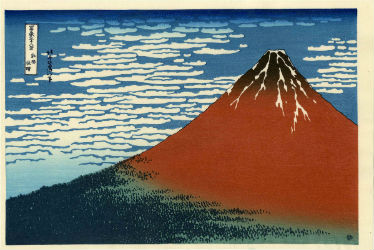
NEW YORK – An exclusive online auction of Japanese woodblock prints will be conducted by Jasper52 on Sunday, Oct. 27. The 163-lot auction features such artists as Kawase Hasui, Hiroshige and Shotei Takahashi. Bid absentee or live online exclusively through LiveAuctioneers.
Nineteen of the prints are by Kawase Hasui (1883-1957), a Japanese woodblock printmaker in the early 20th century. He is widely regarded as one of the greatest artists of the shin hanga style and is known especially for his excellent landscape prints. An evening snow scene (above) offered in the auction is a later edition published by Shoichiro Watanabe in 1946 from the original woodblocks.
Kawase Hasui’s 1937 springtime view of Mount Fuji (below) epitomizes his yearning for the past and preservation in the midst of rapid modernization in Japan. Hasui worked almost exclusively on landscape and townscape prints based on sketches he made in Tokyo and during travels around Japan. The print offered in the auction is a later edition printed from recarved woodblocks and published by Shoichiro Watanabe.

In stark contrast is Katsushika Hokusai’s view of Mount Fuji bathed in red. Katsushika Hokusai, who also used the names Shunro, Sori, Kako, Taito, Gakyojin, Iitsu and Manji, was a Japanese master artist and printmaker of the Ukiyo-e (pictures of the floating world) School. His famous print series “Thirty-six Views of Mount Fuji,” published between 1826 and 1833, marked the summit in the history of the Japanese landscape print. Fuji often takes on a reddish cast in the early morning and late evening, but few are privileged to see it bright red as in Hokusai’s picture. The colors themselves are uncomplicated – red, brown, blue, white and two shades of green, for the most part in solid patches with a minimum of shading. But these colors were chosen and combined with an unerring eye for their weight and value with regard to each other and to the composition as a whole. Surely it was this daring, but sensitive use of bright colors in the best Japanese woodblock prints that commended them to the Western artists of the late 19th century.

Hiroshi Yoshida studied Western-style painting, winning many exhibition prizes and making several trips to the United States, Europe and North Africa to sell his watercolors and oil paintings. While highly successful as a painter, Yoshida turned to woodblock printmaking upon learning of the Western world’s infatuation with the Ukiyo-e art movement. He started his own workshop in 1925, specializing in landscapes inspired both by his native country and his travels abroad. Yoshida often worked through the entire process himself, designing the print, carving his own blocks and printing his work. His print of the Gion Shrine is a posthumous embossed signature edition published by Toshi Yoshida.

Several triptychs are presented in the auction. One of them is Toyohara Chikanobu’s scene of women bathing. The trio of prints measures about 29¾ by 14½ inches. Toyohara Chikanobu (1838–1912) made his artistic reputation in the 1880s with triptychs illustrating political events of the Meiji period, depictions of the Imperial family, and customs and manners of a changing Japan; particularly women and children.

The Jasper52 online auction of Exclusive Japanese Woodblock Prints will be held Sunday, Oct. 27, beginning at 1 p.m. Eastern.
[av_button label=’View the fully illustrated catalog and bid on LiveAuctioneers.’ link=’manually,https://www.liveauctioneers.com/catalog/152565_exclusive-japanese-woodblock-prints/’ link_target=’_blank’ size=’medium’ position=’center’ label_display=” icon_select=’no’ icon=’ue800′ font=’entypo-fontello’ color=’theme-color’ custom_bg=’#444444′ custom_font=’#ffffff’ av_uid=’av-34latz’ custom_class=” admin_preview_bg=”]



